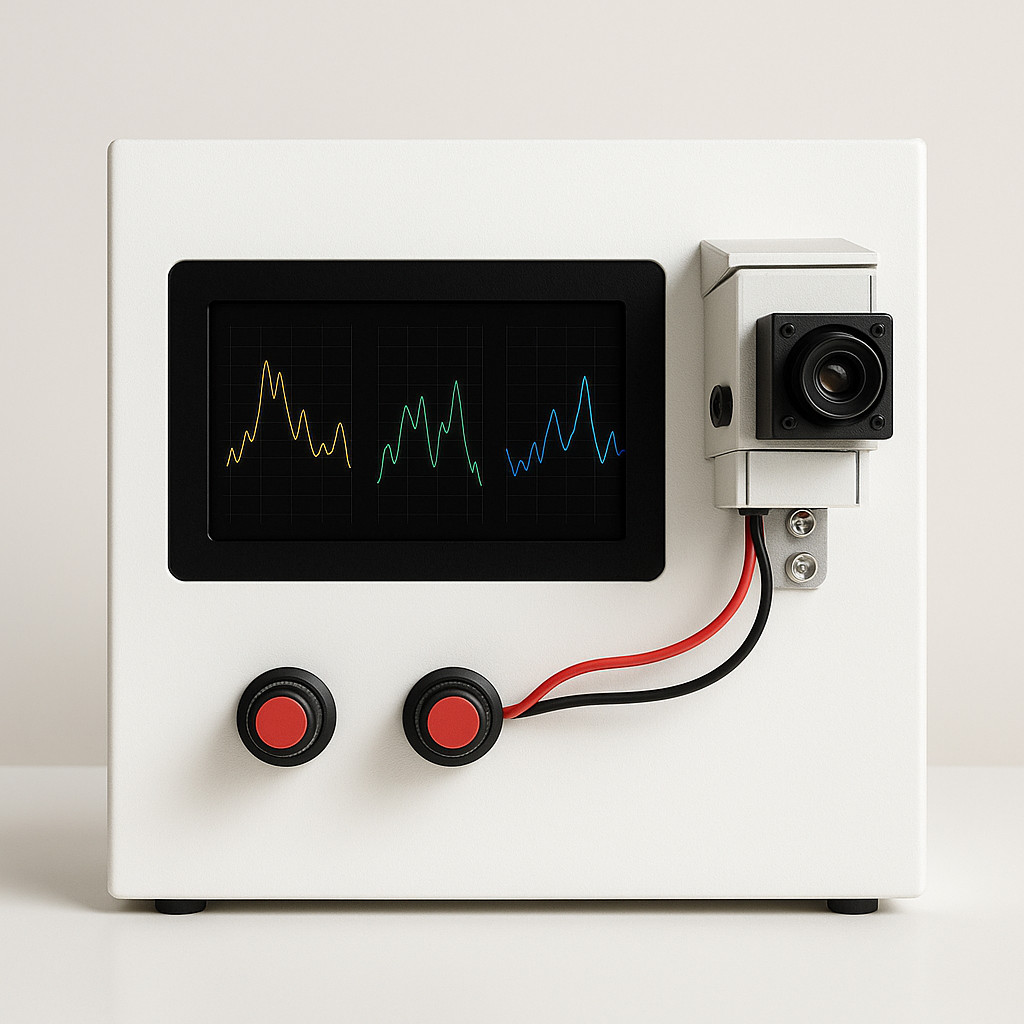Mirror - Interactive Atmosphere Engine
Mirror is an AI-driven atmosphere engine. It senses how a room feels — movement, light, and air — then orchestrates sound and lighting so the space becomes calmer, more focused, and alive.

What is Mirror?
- Not a screen. Not a playlist. Mirror is a living instrument for rooms.
- It reflects people and context (like a mirror) and adapts them into mood, music, and light.
- Built from a sensing + memory + orchestration loop that learns each space over time.
How it feels
- Your gestures ripple into subtle shifts of light and sound.
- Colours in the room blend into chords and tones.
- The space breathes — with tiny “alive” movements that people barely notice but always feel.
Technology that doesn’t pull you into a headset. It makes the room itself respond.
Inputs: Movement, Sound, Environment, and Time
Camera (Movement + Colour)
- Captures gestures, flow, and synchrony through anonymous pose estimation.
- Tracks dominant colours and their motion across sectors of the frame.
- Movements map into intensity, tension, and density; colours add energy, calm, or agitation.
Sound Texture
- Ambient microphones capture noise level and texture of sound in the room.
- Sharp noises → tension; steady hum → neutral baseline.
- Influences how Mirror balances music density and light responsiveness.
Environmental Sensors
- CO₂, temperature, humidity, and moisture shape comfort and fatigue.
- Stale air → gentler lighting, open sound; fresh air → brighter presence.
Temporal Context
- Time of day and season influence atmosphere.
- Morning: gradual build and clarity.
- Evening: softer light, deeper tones.
- Winter vs summer shifts colour and sound palettes.
Privacy-first defaults: no identity, only patterns. Occupancy can be inferred with low-res radar or pressure mats.
Memory Architecture
Mirror doesn’t just react. It remembers — distinguishing fleeting gestures from meaningful Episodes.
What is an Episode?
- A bounded interval where movement/colour deviates from the baseline.
- Stored with: feature stats, colour state, context (time, crowd size), and an embedding for similarity search.
- Episodes cluster across days, giving the space a sense of history.
Memory Layers
- Short-Term (seconds) → raw poses, colour, quick gestures; continuously overwritten.
- Session (≈30 min) → rolling summaries to judge significance.
- Long-Term (hours → months) → rare, unusual Episodes form identity.
- Blended Atmosphere Model
C(t) = α · short-term state + β · session deviation + γ · episode memory
How Mirror Orchestrates Atmosphere
1) Control Signals
- Derived from movement, colour, and memory.
- Continuous: intensity, tension, brightness, density, space.
- Discrete scenes: Calm → Build → High → Release.
2) Sound
- MIDI: bar-by-bar pattern generation to up to 16 channels (drums, bass, pads, leads, textures).
- FMOD: scene-aware stems with smooth, bar-synced transitions and parameter fades.
3) Light
- Alive Movements: imperceptible breathing/flow to avoid static “dead” light.
- Scene logic maps to colour temperature, saturation, spread, and tempo of changes.
Result: a living soundtrack + lightscape — always in sync, always site-specific.
Alive Movements (Lighting)
Static light exhausts people. Mirror adds subtle, biophilic micro‑motions — tiny breaths and stretches in brightness/colour that keep spaces calm and present without distraction.
- Wellbeing: less fatigue, more focus.
- Engagement: a sense of presence and care.
- Identity: a signature feel that sets venues apart.
Roadmap
- Phase 1 — Pilot: Single office floor, alive lighting + FMOD soundtrack, privacy-first sensors.
- Phase 2 — Multi-site trials: Add DALI/DMX adapters, reporting dashboards, cross-site benchmarking.
- Phase 3 — Showcases: Retail/airport deployments; premium “signature atmosphere” packs.
- Phase 4 — Scale: Smart-city wellbeing pilots, large venues, subscription growth.
Why Franky First
Mirror is the natural successor to Franky — but Franky comes first.
- Franky = sound only. It is simpler, faster to pilot, and already a strong product for offices and exhibitions.
- Mirror = sound + light. It expands the same architecture into full atmosphere orchestration, but requires more integration (lighting, sensors, multi-modal orchestration).
- By launching Franky first, we prove the core sensing + memory engine and generate traction, while preparing the way for Mirror as the broader, premium product.
Business model
Possible Buyers
Mirror has clear markets across workplaces, retail, and public spaces:
- Corporate offices: wellness and productivity gains (reduce fatigue, stress).
- Coworking & flex workspaces: differentiation, premium “feel” layer.
- Retail: atmosphere-driven shopping experience; “alive” branding.
- Hospitality: hotels, restaurants, lounges — adaptive ambience.
- Airports & transit hubs: passenger wellbeing, stress reduction, flow management.
- Museums & galleries: adaptive sound+lightscapes to match exhibitions.
- Smart homes (premium): future adoption for high-end residential.
Business model: SaaS subscription per site or per employee; premium packs for specific industries (retail, airport, hospitality).
Market Size (Wellbeing + Smart Environments)
Global Corporate Wellbeing Market
- $60B+ (2023) and growing ~7% CAGR.
- Includes stress reduction, wellness programs, ergonomic solutions, meditation apps.
- Franky fits into “workplace wellbeing infrastructure.”
Smart Building / Smart Office Market
80B+ (2024), projected120B+ by 2028.- Includes lighting, automation, environmental monitoring.
- Franky is a new category: adaptive AI-driven atmosphere.
Combined Entry Market
- ~$140B global market space.
- Franky’s realistic Serviceable Available Market (SAM):
- Mid-to-large corporate offices in EU/US → ~$10B.
Pilot Pricing Example (Offices)
Pilot Deployment (100–200 employees, one floor, 4 weeks)
- Hardware (sensors + lights integration): €8,000 (one-time).
- Software license: €3,000 (per pilot).
- Total pilot: ~€11,000.
Ongoing Subscription (post-pilot)
- SaaS: €20–30 per employee / year.
- Example: 500-person office = €10,000–15,000 ARR.
- Larger enterprise sites (5,000 employees) = €100,000+ ARR.
Expansion Pricing Models
-
Retail / Malls:
- Flat monthly subscription per site (e.g. €2,000–5,000).
- Paid for improved customer dwell time & sales uplift.
-
Airports:
- Large-scale contracts (€250,000+ per terminal).
- Funded via passenger experience / brand budgets.
-
Smart Cities / Government:
- Multi-year wellbeing infrastructure contracts.
- Range: €500,000–5M+ depending on scale.